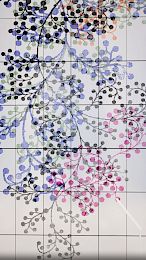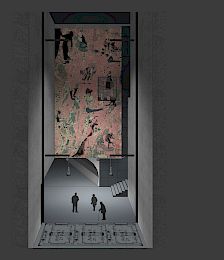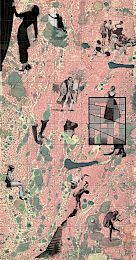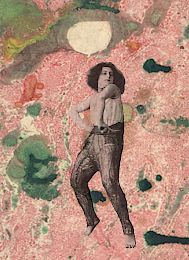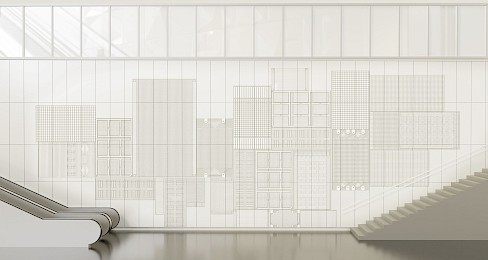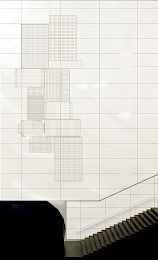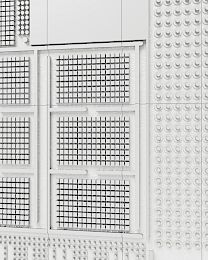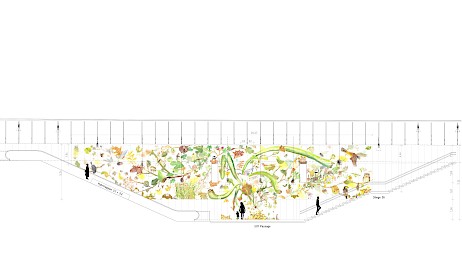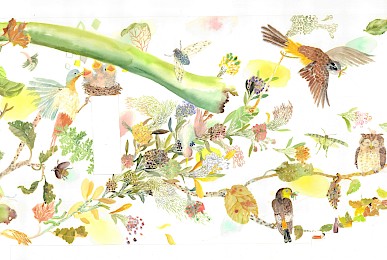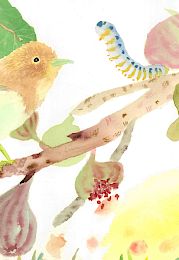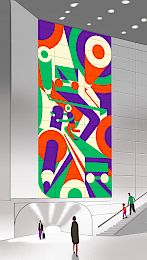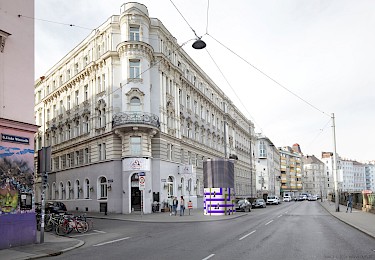Kunst im öffentlichen Raum Wien (Public Art Vienna) has a long-standing collaboration with Wiener Linien. Thanks to the current expansion of the subway system, this success story has reached another high point with three new works of art for the new section of the U2 line (completion in 2028): Katja Davar won the competition for the artistic design in the Pilgramgasse subway station, Phil Collins for the Matzleinsdorfer Platz station and Maria Ziegelböck for the Neubaugasse station.
The route for the new "Pilgramgasse" station of the U2 extension crosses the U4 subway line. The new U2 section of the future crossing station lies partly under the Wien Fluss (Vienna River) and extends from Rechte Wienzeile in the fifth district to Linke Wienzeile in the sixth district. A spacious new station building is being built under the existing U4, which passengers will reach via escalators and several elevators. The station entrances in Hofmühlgasse and Rechte Wienzeile will be connected under the Wien Fluss.
The artistic design is intended to create a distinctive artistic feature in the station's spatial concept that defines the space aesthetically and gives the location an unmistakable identity. Two wall surfaces extending over several levels were available for the design – one in landscape format in the Wien Fluss shaft and one in portrait format opposite the lifts in the Hofmühlgasse shaft – as well as a ventilation tower in the street space of the sixth district. The competition was carried out as an invited, single-stage realization procedure.
The eight-member jury selected the design by Katja Davar on February 27, 2024.
Katja Davar, "Swift Messengers. Migration – das Naturschauspiel des Vogelzugs" (title: "Swift Messengers. Migration – the natural spectacle of bird migration"
Katja Davar's design has two parts: with "Elastic Navigation", she merges the world's nine most important bird migration routes on the enameled wall panels of the Pilgramgasse subway station into a giant abstract pixel graphic of colors and patterns that evokes associations with a world map. On the one hand, it is a reference to the migration flows of birds, which are now influenced by climate change and can therefore also be seen as indicators of it. At the same time, the artist refers to the purpose of Wiener Linien, as the birds' migration routes are characterized by ultimate speed and energy efficiency. The second part of the work, "Picnic songs", depicts a large, nutritious plant - the shape is based on an organizational diagram of a New York railroad line from 1855. Its colored dots appear like berries, one of the vital food sources for birds, which in turn are crucial to the preservation of our ecosystem as seed dispersers.
With remarkable visual lightness, Katja Davar creates a poetic link between nature, technology and current questions about the interrelationship between living beings and their environment. She uses the flight paths of migratory birds to connect the city of Vienna to the larger world structure. Her design allows for both individual and universal interpretations: The reference - the (net)work of migratory birds - that naturally connects and sustains cultures, landscapes and people, can be understood as an allegory to the cosmopolitan, as well as to questions about ecology in a human-dominated age and its complex communication networks. At the same time, the work metaphorically stands for future-oriented, climate-friendly mobility.
--- jury statement
Further competition entries
Esra Ersen, „Die Erinnerung eines Flusses“ (title: "The Memory of a River")
Esra Ersen's design is based on detailed historical research into the population around the Wien Fluss with a focus on the late 19th to early 20th century. The currents of the river are read as a metaphor for the social and cultural development of its surroundings. In the Hofmühlgasse shaft, Esra Ersen envisages an image that fills the entire wall, which she describes as "actually only tangible", namely from the elevator opposite. On the pink marbled background of a historical book cover, she collages the – largely female – figures of a working class between beggars' stairs, laundresses, textile and glass crafts, the amusement industry and prostitution. The work is conceived as a print on the fiberglass-reinforced concrete panels used in this station area. On the wall in the Wien Fluss shaft, Ersen has placed a panel painting in the same materiality, showing the figure of a dancer from Mariahilf from the 1920s.
Judith Fegerl, o. T.
Judith Fegerl's practice is about energy, technology and systemic structures. The starting point for her design is the circuit board, in particular the matrix board, which can be used universally and is suitable for experiments and the development of new circuits. Fegerl uses the structures of different matrix boards to generate reliefs, which she has milled into the glass fiber concrete slabs provided in the Hofmühlgasse shaft. Partially applied round metal applications made of anodized aluminium hint at a possible interconnection. This creates formal references to Otto Wagner's architecture and substantive references to networking within the city and the potential for co-design. Fegerl uses the different relief panels to create compositions of her "Platinenarchitektur" ("Board Architecture") for both station walls.
Haruko Maeda, o. T.
Haruko Maeda's paintings focus on transience and the cycle of life and death. With the finest craftsmanship, she draws on the tradition of the vanitas still life and transports it into the present, not without irony. Maeda's painting for the wall between the escalator and stairs in the Wien Fluss-Schacht shows plants and birds in the cycle of life: birds sit on branches, fly, catch insects, die and hatch in the nest above the crossbeam, fruit ripens, leaves wither, dry leaves collect on the ground, in between there are discarded bottles, cans and oversized cigarette butts. In the center is a fig tree, which the artist always walks past when she passes Pilgramgasse station on her way to the art supply store. She would paint the mural directly onto the enamel panel before firing, just like porcelain painting in an enamel factory.
Christoph Niemann, o. T.
Christoph Niemann's design focuses on the subway network as a connecting element and its nodes as places of encounter. His "wall drawing" for the Wien Fluss shaft – a graphically abstracted depiction of flow and movement that reveals routes, figures and wagons – is intended as a screen print on enamel panels, while the one for the Hofmühlgasse shaft is a digital print on glass fiber concrete panels. Here, the technical innovation of subway planning and construction is depicted on the vertical wall surface. For the ventilation tower on Linke Wienzeile, Niemann has designed a tile mosaic that uses green and purple tiles to depict the interweaving of the U4 and U2 lines.
Location
U2 station Pilgramgasse
Gallery
Further Information
Invited discursive procedure for an artistic design for the U2 station Pilgramgasse, 1050/1060 Vienna
Cooperation KÖR Kunst im öffentlichen Raum Wien and WIENER LINIEN
AWARDING AUTHORITIES
KÖR Kunst im öffentlichen Raum Wien
WIENER LINIEN
PROCEDURE ORGANIZATION
KÖR Kunst im öffentlichen Raum Wien
PRELIMINARY EXAMINATION
Werkraum Ingenieure ZT GmbH, Monika Trimmel
COMPETITION JURY
Juliane Feldhoffer, Curator (as representative of Katrina Petter)
Michael Höpfner, Artist
Silvia Jankovic, District Mayor of the 5th district (indisposed)
Gorana Krajnovic, Architect Architektengruppe U-Bahn | ZT GmbH
Stijn Lernout, Artist
Jeanette Pacher, Head of the KÖR-Jury and Curator
Peter Peternell, WIENER LINIEN
Markus Rumelhart, District Mayor of the 6th district
TECHNICAL EXAMINERS
Karl Auer, Wiener Linien
Jürgen Grabner, City of Vienna (MA 46 Road Safety)
Martin Jatzko, Wiener Linien
Thomas Knoth, Wiener Linien
Cornelia Offergeld, KÖR Wien, Curatorial Director
Martina Taig, KÖR Wien, Division Manager
Monika Trimmel, Architect
Frank Zechner, Planning Team Architecture, Deputy Project Head



